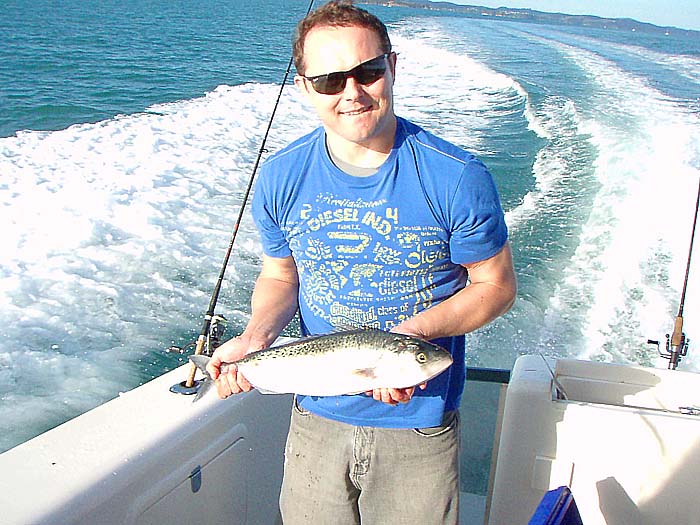

Catch Fish with
Mike Ladle
Information Page
SEA FISHING
For anyone unfamiliar with the site always check the FRESHWATER, SALTWATER and TACK-TICS pages. The Saltwater page now extends back as a record of over several years of (mostly) sea fishing and may be a useful guide as to when to fish. The Freshwater stuff is also up to date now. I keep adding to both. These pages are effectively my diary and the latest will usually be about fishing in the previous day or two. As you see I also add the odd piece from my friends and correspondents if I've not been doing much. The Tactics pages which are chiefly 'how I do it' plus a bit of science are also updated regularly and (I think) worth a read (the earlier ones are mostly tackle and 'how to do it' stuff).
Wish I was there!
My pal Alan in New Zealand has been doing a fair bit of fishing so I've rolled his recent emails into one long web page for you. I love it. Even though I've never been there I feel as though I know the place well.
Hi Mike,
I’ll deal with yesterday’s fishing trip first as it was by far the most exciting.
WAITEMATA TRIP – 27 MARCH 2009
The days are drawing in now as Auckland inexorably marches into the clutches of Autumn. When I got up to go fishing at 6.00 am. everything was shrouded in darkness and there was a decided chill in the air as I walked down the concrete drive to open the gates. Driving to Orakei marina an hour and a half later the thermometer in the car peaked on a high of 11oC and I was glad to have donned a sleeveless polar fleece jacket over my T-shirt.(That's tropical! ML) Despite the chill, the weather was stunning. Hardly a breath of wind and cloudless azure blue skies.
Intrigue was idling gently at its marina berth and was ready to burst into a throaty rumble as soon as the anglers arrived. Once again Peter Hawkins had enlisted the services of Bruce Duncan and they were moving about like ants around a sugar bowl working to ensure a prompt departure. The mooring ropes were slipped at 8.30 am. and we motored for about 5 minutes to our first spot. While the others set about casting and retrieving soft baits I made coffee and prepared some toasted Hot Cross buns with jam and butter. (Why don't I ever go fishing with this man???? ML) Bruce managed to land a 32 cm. snapper on his second cast with a whirl tail Chartreuse Gulp! but the rest of the party remained fishless. High tide was at 8.45 am so there was no current run or breeze to move the boat and help with lure presentation.
After the food and coffee was consumed, Peter made the call to move into deeper water and pointed the bow towards Motuihe channel. When we approached the outer channel, it was evident that there was quite a bit of surface activity as terns and penguins were present in numbers. The fish finder bleeped out a shrill warning and from the screen it was obvious that larger predators below were forcing the bait fish to the surface. Everyone dropped lines in eager anticipation but it was not to be. Even after several positional changes and 45 minutes of concerted casting we still only had the original Snapper to show for our efforts.
The consensus was that the fish would start to feed once the current started to run so we decided to head to the outer gulf and dredge up a feed of scallops for lunch while waiting for the tide to strengthen. The scallop dredging process was very simple. Drop the dredge, tow for 300 metres, attach a buoy via a carabineer, motor forward until the buoy was forced down to the dredge by water pressure and brought it to the surface and then back up to recover the dredge. Four dredges later we had enough scallops for a decent feed (see photographs). The minimum size limit for scallops is 100 mm so they are a meaty delicacy, best eaten fresh cooked in butter with a splash of white wine.
We completed several drifts near the scallop beds over the next hour but were unable to find any snapper that were willing to join the solitary fish on board. It was then decided that the best plan would be to motor across the gulf to the back of Waiheke, anchor up near some foul ground, have lunch and then fish in earnest using the scallop shells and frills as burley. Plan decided, Peter forced the twin throttles forward and Intrigue burst on to the plane towards its next destination. The boat sped on its way and Bruce began cleaning the scallops while Stuart and I prepared the salad, fresh baked bread and the sage & onion stuffed rotisserie chickens that we’d brought for lunch.(The very though makes me hungry ML)
Halfway across the inner gulf the fish finder alarm went wild screeching and pointing an electronic finger to a huge school of fish below. Peter marked the spot on the GPS, slowed the boat and re-traced the route to the cause of the electronic disturbance. The finder screen was alive with fish as Peter cut the motors we all dropped tools and picked up fishing rods eager to enter the fray. We harassed the school for 30 minutes and only managed to catch a couple of undersized snapper. By now it was getting close to 1.00 pm so we stopped fishing and returned to lunch preparation. Peter did not bother to anchor as there were no boats visible and the sea was calm with negligible current. The conditions were so placid, and the drift so slow and measured, that over lunch someone quoted Coleridge “Day after day, day after day, We stuck, nor breath nor motion ; As idle as a painted ship upon a painted ocean”.(Harry never waxed as poetic when we were fishing in Swanage Bay ML)
After lunch the plan was to throw out some scallop burley, have a couple of casts and then head to the foul as per the original arrangement. As I left the cockpit Stuart casually mentioned that he’d had a couple of touches on a Sassy shad with a hint of Orange. I do not know why but I decided to change my lure and went back inside to thread a 3” Orange Sassy shad onto the ½ oz. Nitro jig head I’d been using all day. I then headed up to the bow with Bruce to commence casting.
Bruce advised me to cast upstream of the boat and work the jig head in an arc around the front of the boat. I did this and allowed the lure to sink slowly to the bottom. As soon as it touched down I tightened the line and gave the lure a small jiggle. What happened next I’ll never forget. The lure was slammed so hard that the rod tip was dragged down into a fighting arc instantly. The power of the fish was brutal. Line sped off the spool in a blur as the fish made a searing 100 metre run against 3 lb of drag pressure. Finally after what seemed eternity the fish stopped pulling line. I started to pump it back to regain line only for it to surge off again and regain its share with interest. Bruce and I picked it for a snapper and a big one from the nodding of the rod tip and Bruce suggested short-stroking the rod to try and turn its head. This seemed to work but every time I managed to get it off the bottom it decided to head back and strip off more line. This “to-ing and fro-ing’ continued for about 10 minutes but it was evident that the fish was tiring as the surging runs began to decrease in length and ferocity. By now the snapper was almost below the boat and as I lifted the fish and it surged away I could feel its tail beating on the trace. I switched sides of the boat to change the angle and this eliminated the likelihood of the trace being severed by a beating tail. We’d deliberately kept quiet so that no one at the back of the boat was aware of the size of the fish being played. As I moved down the side of the boat and drew the fish towards the surface Bruce made them aware of the snapper coming up from the depths and pandemonium broke out amongst the crew as they wound in furiously and found the net. The fish was spent by now and after 15 minutes struggle it slid easily across the surface and into the waiting mouth of the net.
The snapper was an absolute beast and dragged the scales down to 18 lbs. Not bad for a 3” soft plastic lure rigged on 8 lb braid! A personal best and easily my finest saltwater capture to date. The power of a snapper's jaws is incredible. Imagine a cross between a hole punch and bolt cutters and you are starting to get the picture. Check out the photograph to see the mess that it made of the lead head jig. Our theory is that it was feeding on the scallop ground bait and mistook the Sassy shad for scallop roe.
The decision was made to move to Sergeant’s Channel soon after the capture of the big snapper to take full advantage of the first three hours of the making tide. On the way there we spotted a fast moving school of kahawai working and decided to toss lures at them for 15 minutes. Bruce lead the way and hooked 3, six pound fish on a 3” Gulp! Black shad back-to-back before the rest of us could get off the mark.
When we arrived at Sergeant’s channel conditions were perfect. Plenty of tide run and a slight breeze to slow down the progress of the drifting launch. The team at the rear of the boat immediately started to catch snapper between 34 – 38 cm. on soft baits and pilchards and Bruce & I were getting loads of bites but unable to hook up. I was finding it particularly hard to connect and Bruce suggested a change in lure placement and line angle might be worth trying. Essentially cast further away from the boat upstream. First drop and the lure (by now a Zoom Smoke shad 3”) was absolutely monstered by another big fish. This one charged off into the current and was intent on tearing line forcefully from the spool in lengthy bursts. Every now and again it turned and ran with the current which made it even more difficult to control. Eventually I was able to short-stroke its head up and use the current to push it to the surface and into the waiting net. At 8 lb it was another excellent fish and turned out to be the second biggest caught all day. I managed to catch a smaller 4 lb snapper on the next drift using a similar strategy before I lost my lure on the bottom and was forced into the cabin to replace my trace.
We persisted in Sergeant’s channel for another 45 minutes before heading home to Orakei marina. All in all we’d only caught twelve fish in total but the quality was excellent. I just had three fish all day but with a combined weight of 30 lb. you would have to be mad to complain. I cannot believe how lucky I am to have the opportunity to fish on a vessel like Intrigue with such skilled fishermen (and top company) regularly.
Look forward to your comments.
Very best regards to all.
Alan
I replied as follows (numerous expletives removed).
Hi Alan.
What a fish, you well deserve it after all your trials and experiments. They're all good fish so I look forward to the pictures. I bet you've got a smug expression. You did get some pictures?????
It's still cool here. I might have ago for a trout next week (the season starts on Wednesday).
Mike
Alan's next session was from the shore -
Hi Mike,
I trust that the photographs and story from my latest excursion on Intrigue made it through the ether overnight. As I mentioned I had been fishing in Whangamata on 14 March but had been too busy to write and fill you in on the details. Here goes:-
WHANGAMATA – 14 March 2009
The day dawned overcast and cool. The wind was gusting from the South East at 10 – 15 knots and even though the sun occasionally peeked through holes in the clouds it was not enough to raise the air temperature above a pleasant 18oC. Our trip to Whangamata had coincided with a late afternoon low tide. The tides were large Spring tides so there it was not as easy to get out onto the mudflats as normal on account of the extra water.
Despite this, I was determined to fish the last two hours of the ebb tide and this meant that I had to wade through the knee deep water in the channels to get onto the mudflats proper. When I reached the main channel the water was flowing strongly and several distinct micro channels were evident that would almost certainly hold snapper. That is, if they were still in the harbour.
I slid a Berkley PowerBait minnow (3” Black shad) onto a ¼ oz Nitro jig head at the water’s edge and lobbed it upstream (11 o’clock) into a defined rip. The lure plopped in and sank quickly to the bottom where the current made it bounce enticingly along the bottom. I kept the line tight and when it reached the 2 o’clock position it was monstered by a snapper. The fish shook it’s head vigorously and tore away from the shore but, at 30 cm. long, it was no match for the brutal drag setting and was quickly drawn into the shallows for release. Yet again a first cast fish!
Feeling chuffed, and confident that I was going to have an entertaining session, I re-cast the soft plastic minnow back into the rip slightly downstream from the initial strike. Once again it sank to the bottom without incident and proceeded to dance along the bottom seductively, helped along with the occasional rod twitch. This time when the hit came the fish did not stay attached and I reeled in the minnow to find that its tail had been nipped off cleanly. I re-baited and repeated the procedure – right down to the bite and retrieval of a tail less minnow. This happened six times over the next 20 casts and I was charging through soft plastic like a shareholder in Berkley. When I was not getting tapped by snapper I was getting snagged on horse mussels and losing the jig head. Bugger! It was like tossing a coin and only ever getting back heads.
I’d covered a fair bit of ground while this was going on and decided that it may be prudent to retrace my steps to where I’d started as the estuary was widening, and the tide flow was less pronounced, which correlated to less bites. I went back to the starting point and began to walk upstream. First cast and the lure was spanked by a small kahawai. It ran parallel to the shore at high speed when first hooked but threw in the towel when side was applied with the heavy drag. This was a relatively rare capture as kahawai do not seem to take soft plastic and I suspect that the increased tidal current was a factor.
By now I was down to my last soft plastic minnow so opted to change to the ever reliable Yo-Zuri bibless 3D Vibe minnow. This change coincided with a slackening in the ebb flow as there was only 45 minutes left until dead low tide. The bibless minnow was an inspired choice as it allowed me to fish the deeper channels further out into the estuary. Within 5 casts on my rip-pause-wind retrieve I was hooked up on another small kahawai which gave a spirited fight for a couple of minutes before being beached in the shallows. Another 20 casts later I was hooked up again on a small kahawai which performed identically to the first.
Then I foul-hooked a bully in the head with the minnow as I was ripping the lure up the side of the main channel. Damn! Remarkably it swam away with in no apparent discomfort. Two casts later the lure was rising up the channel wall when it was monstered by another 30 cm. snapper. This fish gave a more spirited performance than the first and took a couple of minutes longer to bring to the shore for the obligatory photograph and release.
I carried on for as while before deciding to return home as the tide reached dead low. On my last cast I proceeded to throw my lure an extra 60 feet as it parted company at the braid – trace knot. In all, I’d played and landed 5 small fish but the toll on gear was substantial. 7 soft bodies, 3 jig heads and a bibless minnow had been lost during the session.
A couple of things are starting to become apparent namely:-
• Shad soft plastics work well when the current is running but it is necessary to change to a pattern with more movement when the tide slackens. This can be to a paddle tailed soft plastic or hard bodied minnow.
• Bibless minnows are effective in low current flows, especially when a rip-pause retrieve is introduced.
• Do not strike hard when the fish are taking short unless you want to make a donation to soft plastic manufacturers.
• Re-tie on the trace after every 60 minutes else it is inevitable that the trace – braid knot will fail after 1.5 hours constant use. What knot do you use and have you found this?
All in all it was great to be back on the estuary even if the fish caught were not particularly large.
Tight lines,
Alan.
If you have any comments or questions about fish, methods, tactics or 'what have you!' get in touch with me by sending an E-MAIL to - docladle@hotmail.com
A fine bag of scallops.
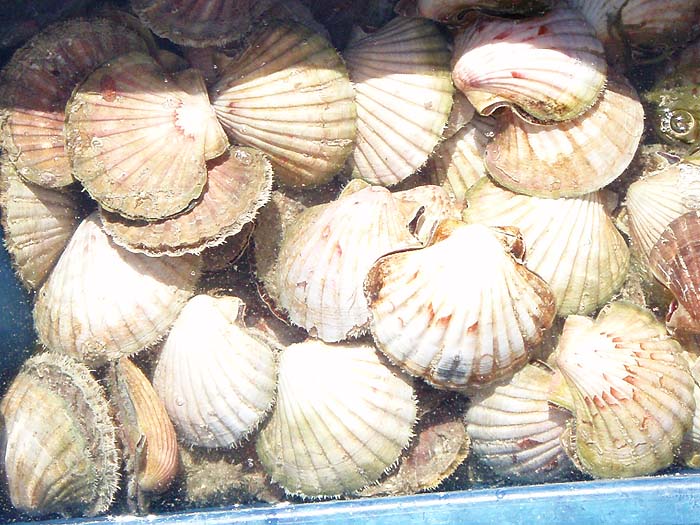
Interior.
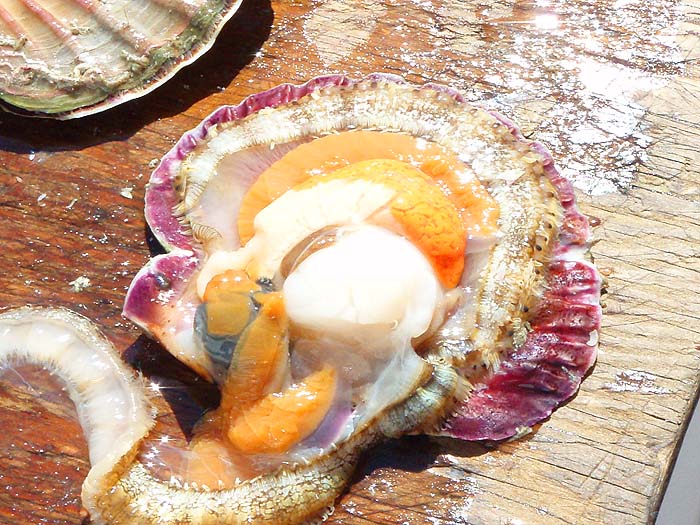
Eight pounder.
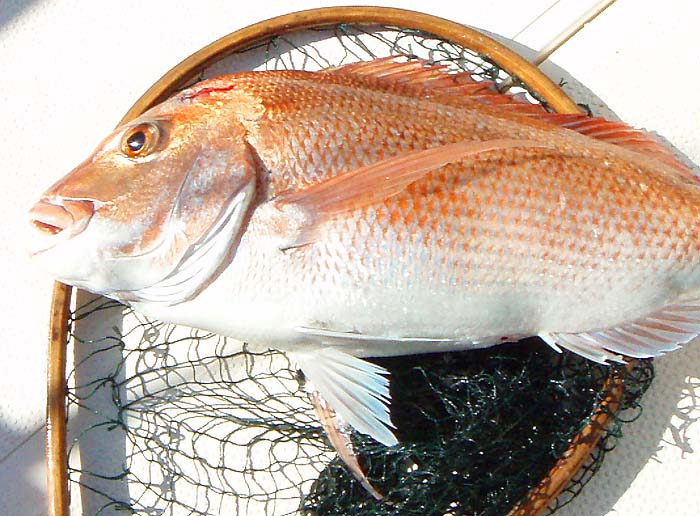
Eighteen pounder.

Mangled jig head.
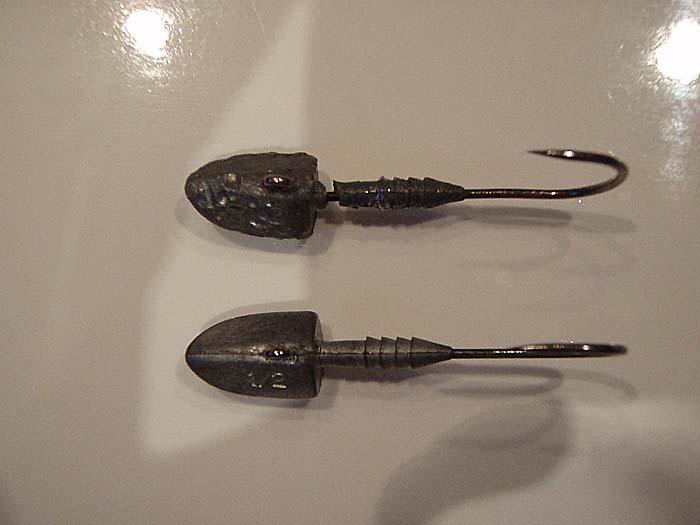
Tailless.
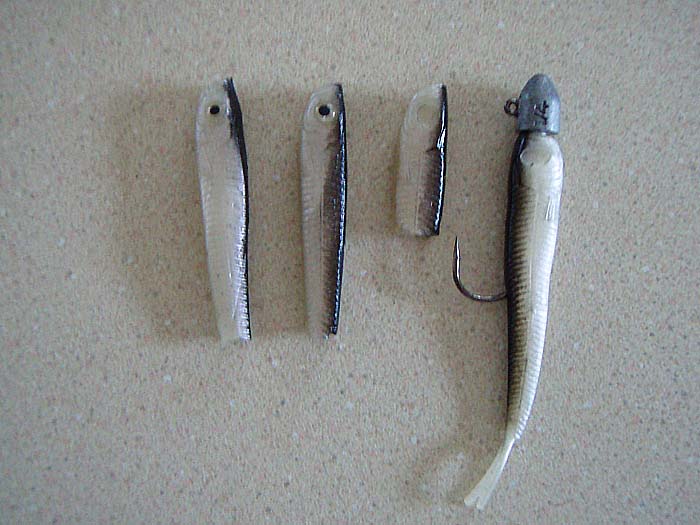
Kahawai.
